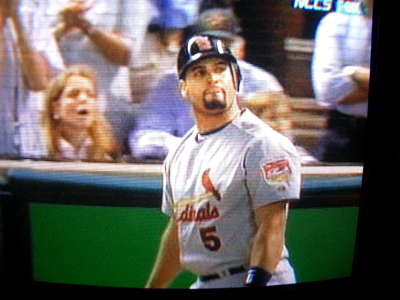Pete called me this afternoon to say he’d heard something on the news he found sad and shocking: Bill King, who did play-by-play for the Oakland A’s for the past 25 seasons, had died suddenly after undergoing surgery. Strange to say, I was actually shaken.
A couple weeks ago, I was listening to him broadcast on the next-to-last day of the season. It was a nothing game from Seattle, and I can’t say I remember anything about it. But I do remember hearing Bill mention Pat Piper, the legendary and long-gone field announcer at Wrigley Field, and thinking how the one thing I’d really miss about the season would be not hearing him again until springtime.
(I just discovered, though, that if you’re willing to pay $7.95 to MLB.com, you can get the full online archive of A’s radio games (and every other team’s, too) for 2005. Not sure how long the access will last, but I paid.)
I wrote a little something about King a couple months ago, about how he’d casually, and humorously, tossed off a reference to Trotsky while communicating his distaste of interleague play. His obituaries mention something I remember hearing a long time ago but had forgotten — that King was fascinated with Russian history and read avidly on the subject. So Trotsky was right in his ballpark.
King was an institution here not just for his A’s work, but for his phenomenal overlapping tenure with the Golden State Warriors (from ’62-’83) and Oakland/Los Angeles Raiders (’66-’92). Perhaps it was just that I enjoyed his style so much — his panache with language, his knowledge, his energy, his humor, his nearly unfailing sense of dramatic shifts in the contest he was describing — but I really believe he called a different kind of game than most of us are accustomed to hearing.
The mean streak Harry Caray showed in his best years and the mawkish sloppiness that marked his work later (nearly his entire Cubs tenure, from what I can tell, when he became first icon, then caricature) was absent in King. He didn’t indulge in the raw homer-ism and smug know-it-all-ism that makes Giants games so hard to listen to (Krukow and Kuiper, worst offenders; Jon Miller ain’t half bad, though). You would know who he was pulling for, but you never got the sense that he believed his team deserved to win.
A King broadcast was like listening to one of your smartest, most entertaining friends unwinding an elaborate yarn. He was someone you could imagine having over to dinner, maybe, and know you’d be in for an evening you’d never forget. Kate and I actually talked about inviting him, knowing that kind of thing never happens.


